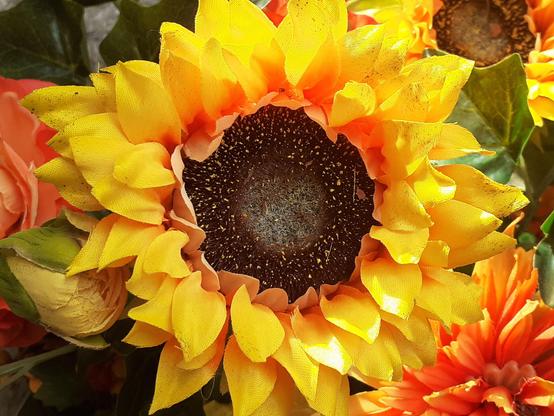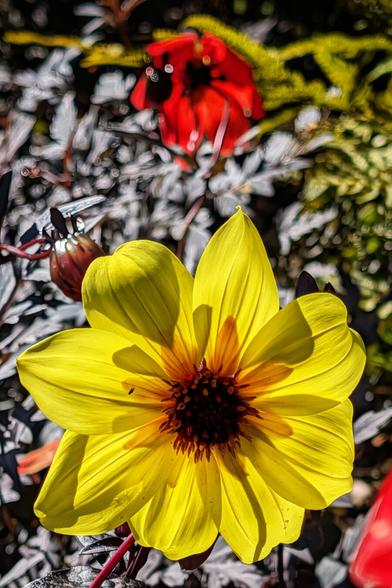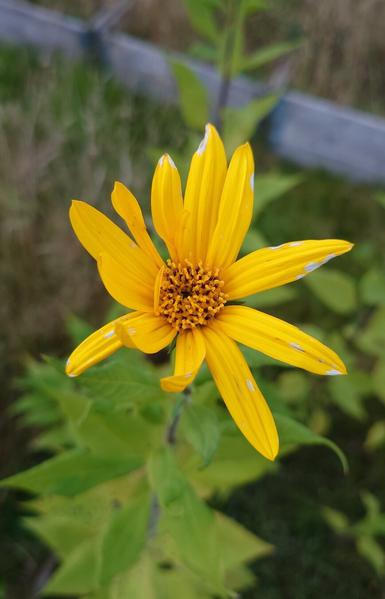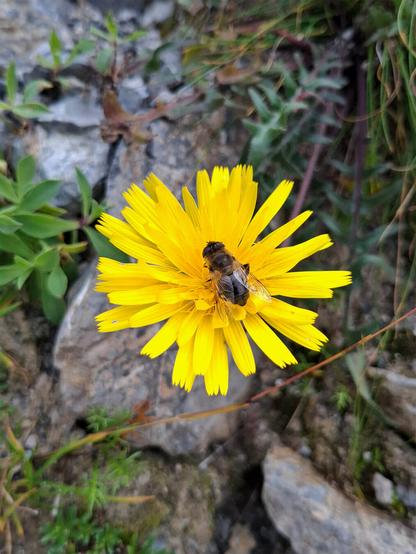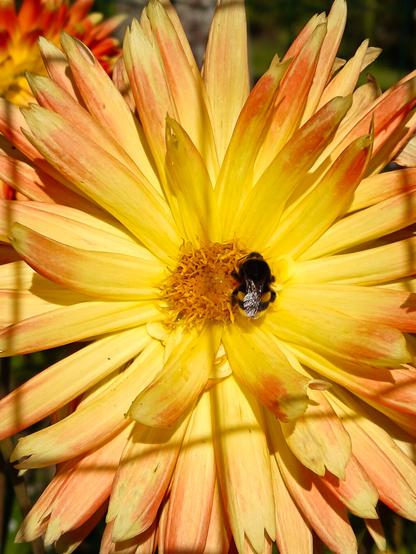Sunshine in Petals. #yellowflower #dahlia #gardenlife #floralbeauty #summerblooms #macrophotography #flowerpower #naturelover #brightcolours #blooming #closeupphotography #smartphonephotography #photography
A beauty of imperfection 😍
Helianthus tuberosus
#Jordskokk #HelianthusTuberosus #NorskPix #YellowFlowersOfPixelfed #YellowFlower
Helianthus tuberosus
#Jordskokk #HelianthusTuberosus #NorskPix #YellowFlowersOfPixelfed #YellowFlower
A drone fly (Eristalis tenax) is perched on a grey hawkbit (Leontodon incanus, Grauer Löwenzahn) in bloom. The flower is growing in a rocky alpine environment. To the left, the fleshy, bluish-green leaves of sea campion (Silene uniflora, Klippen-Leimkraut) are visible. The background consists of rugged stones and sparse alpine vegetation.
#alpine #yellowflower #flower #wildflower #dronefly #eristalis #eristalistenax #drohnenfliege #schwebefliege #hawkbit #leontodon #leontodonincanus #loewenzahn #grauerloewenzahn
#alpine #yellowflower #flower #wildflower #dronefly #eristalis #eristalistenax #drohnenfliege #schwebefliege #hawkbit #leontodon #leontodonincanus #loewenzahn #grauerloewenzahn
A close-up of my hand gently holding a small cluster of delicate yellow flowers of common bedstraw (galium verum) in a grassy meadow.
Foto by Laner Sepp.
#hand #bedstraw #galiumverum #gelbeslabkraut #labkraut #wildflower #green #yellowflower #meadow
Foto by Laner Sepp.
#hand #bedstraw #galiumverum #gelbeslabkraut #labkraut #wildflower #green #yellowflower #meadow
Little friend enjoying flower as bright as the sun 🌞
#photography #nature #naturephoto #naturephotography #bee #bumblebee #savethebees #flower #flowerpower #bloomscrolling #yellowflower #yellow #summer #latesummer #finnishsummer #august
#photography #nature #naturephoto #naturephotography #bee #bumblebee #savethebees #flower #flowerpower #bloomscrolling #yellowflower #yellow #summer #latesummer #finnishsummer #august
🌻
Dreaming Sunflower acrylic painting on canvas.
Buy it from my Etsy shop:
https://www.etsy.com/listing/4355714679/dreaming-sunflower-original-painting?ref=shop_home_active_1&logging_key=92890903b231d510993e5d2f678fd46ae0fcea0d%3A4355714679
https://www.etsy.com/listing/4355714679/dreaming-sunflower-original-painting?ref=shop_home_active_1&logging_key=92890903b231d510993e5d2f678fd46ae0fcea0d%3A4355714679
#sunflowerpainting #sunflower #flowerpainting #yellowflower #paintingoncanvas #artsale #artforsale #etsy #bloomscrolling #humanartist #noai #NotAI #acrylicpainting #originalart #originalpainting
Common Toadflax (Linaria vulgaris, Gewöhnliches Leinkraut) is a hardy perennial native to Europe and Asia, often found in meadows, roadsides, and dry, sunny habitats. Its bright yellow and orange, snapdragon-like flowers bloom from summer into autumn, attracting bees, bumblebees, butterflies, and other pollinators, thus contributing to late-season nectar availability. Ecologically, it also provides shelter for small insects and serves as a host plant for certain moth species. Traditionally, it has been used in herbal medicine for its diuretic, mild laxative, and anti-inflammatory properties, particularly in treating liver and gallbladder issues, skin irritations, and hemorrhoids, though its internal use should be approached cautiously due to the presence of potentially toxic compounds.
#commontoadflax #toadflax #linaria #linariavulgaris #leinkraut #yellowflower #flower
#commontoadflax #toadflax #linaria #linariavulgaris #leinkraut #yellowflower #flower
European Goldenrod (Solidago virgaurea, Gemeine Goldrute) is a perennial wildflower native to Europe and parts of Asia, thriving in meadows, forest edges, and nutrient-poor soils.
It’s an important late-summer nectar and pollen source for bees, hoverflies, butterflies, and other pollinators when few other plants are blooming. Its seeds also feed certain insects and small birds, and its dense growth provides microhabitats for invertebrates.
Traditionally, European Goldenrod has been used as a diuretic and anti-inflammatory, particularly in herbal remedies for urinary tract health, kidney and bladder stones, and to support wound healing. Its flowers and leaves contain flavonoids, saponins, and phenolic acids, contributing to its antimicrobial and antioxidant properties.
#solidagovirgaurea #goldrute #gemeinegoldrute #goldenrod #yellowflower #flower #green #meadow
It’s an important late-summer nectar and pollen source for bees, hoverflies, butterflies, and other pollinators when few other plants are blooming. Its seeds also feed certain insects and small birds, and its dense growth provides microhabitats for invertebrates.
Traditionally, European Goldenrod has been used as a diuretic and anti-inflammatory, particularly in herbal remedies for urinary tract health, kidney and bladder stones, and to support wound healing. Its flowers and leaves contain flavonoids, saponins, and phenolic acids, contributing to its antimicrobial and antioxidant properties.
#solidagovirgaurea #goldrute #gemeinegoldrute #goldenrod #yellowflower #flower #green #meadow
💦 Morning dew on an evening primrose 🌼
#eveningprimrose #yellowflower #flowers #teunisbloem #gelebloem #nature #naturephotography #natuur #naturelovers #natur
#eveningprimrose #yellowflower #flowers #teunisbloem #gelebloem #nature #naturephotography #natuur #naturelovers #natur
